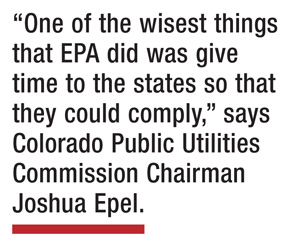McConnell Maligns Clean Power Plan
Those of us following the politics of coal country and throughout the Appalachia region understand the popular political sentiment there – that coal is the lifeblood of the area and that President Obama is poisoning the well. So it’s no surprise that Senate Majority Leader Mitch McConnell, R-KY is now urging not only his state but others to buck the Clean Power Plan, proposed last June by the U.S. Environmental Protection Agency (EPA) and backed by the White House.
McConnell’s opposition is predicated on the belief that the retirement of coal plants or the installation of modern technologies would be prohibitively expensive and that people would lose their jobs as a result. The senator projects in an editorial he has written that it would cost his state $2 billion in lost economic productivity – something that many analysts say is unfounded and shortsighted.
 “Don't be complicit in the administration's attack on the middle class,” writes Senator McConnell, in the Lexington (Ky.) Herald-Leader. “Think twice before submitting a state plan – which could lock you in to federal enforcement and expose you to lawsuits – when the administration is standing on shaky legal ground and when, without your support, it won't be able to demonstrate the capacity to carry out such political extremism.”
“Don't be complicit in the administration's attack on the middle class,” writes Senator McConnell, in the Lexington (Ky.) Herald-Leader. “Think twice before submitting a state plan – which could lock you in to federal enforcement and expose you to lawsuits – when the administration is standing on shaky legal ground and when, without your support, it won't be able to demonstrate the capacity to carry out such political extremism.”
The Clean Power Plan, which is expected to be finalized by summer, would require a 30 percent cut in carbon dioxide emissions by 2030. States would have another year after learning of the rule’s final terms to submit their blueprints for federal approval. States would have several options to comply, such as swapping older coal-fired plants for newer ones that run on natural gas or renewable energy. Or, by running coal-fired plants more proficiently, instituting energy efficiency programs for consumers, or allowing power plants to trade credits amongst each other and across states lines, or any combination of the above – all to reduce carbon levels.
However, the majority leader’s analysis fails to consider the potential job gains that would be created under the clean air proposal – not to mention the improvement in air quality, and health. In fact, the growth potential in alternative energy fields is outpacing those in the coal sector, where coal seams are becoming thinner and increasingly more difficult to work.
According to McConnell, the rise in electric rates is reason enough to oppose the Clean Power Plan. But what he does not say is that Kentucky’s rates would go up by 75 percent if it does not collaborate with the president, writes Brian Potts and David Zoppo, attorneys for the law firm Foley & Lardner, in RealClearEnergy.
“The reason for this is somewhat complicated, but it comes down to the fact that, if a state refuses to develop a plan to implement the rule, then the EPA will step in and do it for them,” they say.
“Just saying no won't get the state out of having to comply; it will just make compliance more difficult.”
In a separate story, Potts writes that other states would also see similar rate hikes if they fail to submit their own proposals: Texas, for example, says that its rates would rise by 10 percent under the administration’s plan. But if it does not participate in it and the federal government imposes its will, Texas’ rates would climb by 44 percent. Meantime, Utah, Wyoming, Nevada and Illinois are undergoing the same introspection but according to Potts, would all see double-digit increases in their electricity rates if they do not cooperate.
Despite the finger-wagging and political-posturing, some coal-dependent states like Georgia, Colorado and Wyoming are preparing for a carbon-constrained world. Even Kentucky’s utilities are not sitting idle, having installed pollution controls on some older coal plants.
Georgia, for example, is retiring a quarter of its coal plants, replacing them with inexpensive natural gas and some utility-scale solar plants. Wyoming has started up three natural gas-fired power plants to replace three coal-fired plants. And Colorado says that it is also pretty far along in complying with the Clean Power Plan, although some of its municipal utilities and rural electric cooperatives will have a more difficult time.
“One of the wisest things that EPA did was give time to the states so that they could comply,” said Colorado Public Utilities Commission Chairman Joshua Epel in an interview with this reporter.
“It gives regulators and others quite an appropriate planning horizon.... If EPA continues to provide flexibility, as it has been doing, Colorado as a whole will be in very good shape.”
Other coal-producing states such as West Virginia have plans to sue the EPA over the Clean Power Plan. But what those same voices don’t say is that natural gas already is positioned to replace many older coal-fired plants there: The state has permitted 2,300 gas wells, of which 700 of them are currently active – each of which comes with a $5 million investment that flows into local economies.
IHS Energy projects a $9 billion infusion into the state by 2035, which will employ 57,000 people in gas-related fields, or 7 percent of the West Virginia’s workforce. Average pay: $90,000 a year, similar to that of the coal sector. Meantime, the current coal industry workforce is 20,000 in West Virginia, and stagnant.
Natural gas “is a wave that is growing, and it is far from having crested, and it’s going to sweep through the Ohio Valley like no other wave that has ever descended down through our valley,” says Jonathan Turak, who is representing WV landowners sitting atop shale gas deposits, in a Charleston Gazette report.
Senator McConnell is right to be concerned about the Clean Power Plan’s implications on coal and the subsequent economic fallout in his state. But he fails to contemplate that regardless of what EPA says or does, other fuels will step up to fill the void – fuels that are cleaner and that also provide economic opportunities.
Please join us at the Public Utility Fortnightly’s conference in Washington, DC on April 9-10 to discuss disruptive technologies and the utility of the future. Details and registration found here: http://www.fortnightly.com/UTUF





